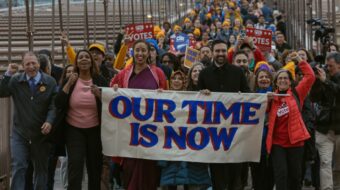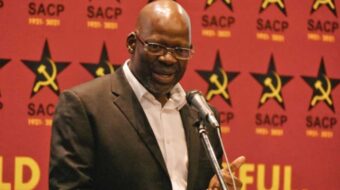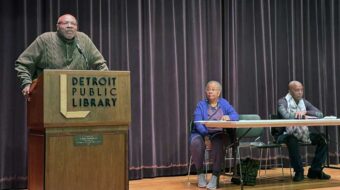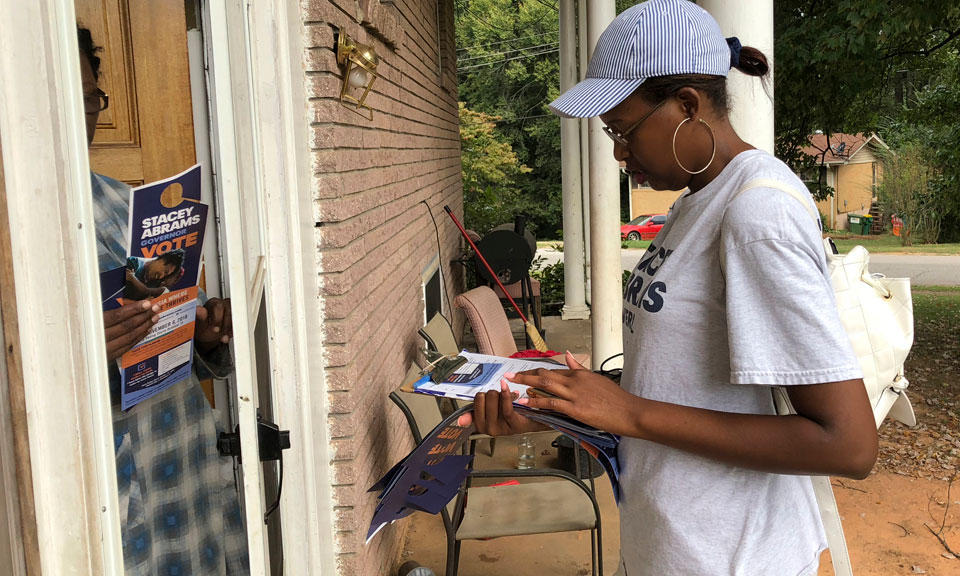
The future of U.S. constitutional democracy rests on a knife’s edge. The November elections offer an opportunity to deal a blow to the GOP fascist movement. Still, the outcome depends on the ability and capacity of the broad pro-democracy coalition to turn out every voter possible.
Like many of you, I’m deeply involved in this titanic battle. So, I was eager to dive into the new book of essays, Power Concedes Nothing: How Grassroots Organizing Wins Elections, edited by veteran progressive activists Linda Burnham, Max Elbaum, and Maria Poblet.
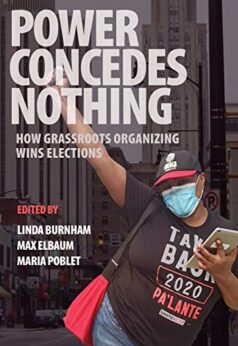 The book doesn’t disappoint. Every page contains a treasure of insights and lessons from those on the front lines in the day-to-day work of grassroots voter mobilization, political infrastructure development, and coalition building for a multi-racial democracy in some of the most critical battleground states, including Georgia, Florida, Texas, Michigan, Pennsylvania, Arizona, and Virginia.
The book doesn’t disappoint. Every page contains a treasure of insights and lessons from those on the front lines in the day-to-day work of grassroots voter mobilization, political infrastructure development, and coalition building for a multi-racial democracy in some of the most critical battleground states, including Georgia, Florida, Texas, Michigan, Pennsylvania, Arizona, and Virginia.
The work is taking place on a tremendous scale, including expanding the electorate by registering hundreds of thousands of new voters while combatting voter suppression. The experiences include building statewide independent political formations that operate year-round, building broader electoral alliances with the Democratic Party, and grassroots activists running for office and winning.
The essays reflect the maturity of left and progressive movements that, in the past, often underappreciated or rejected the need for an electoral strategy. Enormous experience has been accumulated in a relatively short time fighting for the needs of our communities and preserving and expanding democracy.
The lessons are clear. Organizing around issues, protesting, and pressuring elected officials is essential but not enough. Contesting and building alliances in the electoral arena must be part of the mix—transforming politics, parties, and democracy in the process.
“We need to build a relevancy to the lives of working people and people of color that overcomes the entrenched cynicism that demobilizes and disengages,” writes Cristina Mendoza of the Florida for All coalition in one chapter.
Building broad and racially diverse alliances to elect and govern is a central thread. The priority is empowering historically disenfranchised and marginalized communities—including African Americans, Latinx, Asians, and Native Americans—in states with rapidly changing demographics.
According to Jon Liss of the New Virginia Majority, a winning strategy must identify the forces comprising the majority “voter bloc.” In Virginia, that means finding the intersection between movements and diverse constituencies, uniting Black, Latinx, and immigrant voters with labor and the multi-racial working class, and building left-center political alliances.
The GOP and extreme right have a 20-year head start in state and local organizing. They have gained power in local offices, state legislatures, Congress, the presidency, and the courts by mobilizing voters based on racism, misogyny, and fear and building a powerful propaganda machine.
However, the people’s movements are organizing, too. The stories in Power Concedes Nothing recount how the struggles and movements that erupted in the wake of Trump’s victory in 2016 draw upon earlier battles. The relatively short period makes the achievements all the more remarkable.
In the 2020 election, the anti-rightwing coalitions faced extraordinary challenges posed by the pandemic, economic crisis, voter suppression, and the historic protests over the racist police murders of George Floyd, Brianna Taylor, and others. These groups contributed mightily to the largest voter turnout in U.S. history, including 81 million votes for Joe Biden and Kamala Harris and winning Democratic majorities in the House and U.S. Senate.
In one essay, Linda Burnham interviews leaders from New Georgia Project, Black Voters Matter, Georgia Alliance for Latino Rights, and Showing Up for Racial Justice who are working to mobilize Black, Latino, and white voters. They recount building the formidable alliance that was instrumental in swinging Georgia blue in 2020 and then pivots to elect Sens. Rafael Warnock and Jon Ossoff in the special election two months later, giving Democrats the Senate majority.
The Georgia experience has deep roots in the fight for African American equality and voting rights, and more immediately in Stacey Abrams’ campaign for governor against Brian Kemp in 2018. The obstacles, including voter suppression, were daunting, and Abrams’s campaign was audacious.
Georgia is undergoing rapid demographic shifts. Abrams recognized the 1.2 million unregistered Black, Latino, Asian, and unmarried white women voters constituted a powerful untapped reservoir of support. The New Georgia Project, led by Nsé Ufot, registered 600,000 of them.
At first, DNC officials dismissed Abrams’ campaign as unwinnable. But the campaign proved it could be competitive and even win with an effective strategy. The GOP stole the election through voter suppression, but nevertheless, that experience “changed the state and shocked the nation,” leading to an all-out investment in the 2020 election and Abrams’ campaign in 2022.
“Part of the lesson for the rest of the country is to fund these groups,” says Cliff Albright of Black Voters Matter. “Fund these states that are so often neglected and have literally been written off for decades as conservative bastions that are going to be red no matter what.”
The independent forces are interacting with and impacting the work of the Democratic Party in many places. Grassroots activists are being elected to leadership and running for office. In these places, the multi-racial working class, people of color, and women are shaping a more effective instrument to advance their interests.
In Arizona, the Democratic Party too often dismissed Latinx voters as “low propensity” or “infrequent” voters, so it made little investment. “When our community leaders would urge the Democratic Party to invest in our communities, they ignored us,” writes Cesar Mendoza of Living for United Change in Arizona (LUCHA). “Instead of organizing the Latinx communities central to any path to victory for Democrats, they talked a lot and came around once every four years for votes.”
The Latinx community began self-organizing to defeat SB 1070, the anti-immigrant and racist “show me your papers” law that allowed widespread racial profiling of anyone suspected of being undocumented. SB 1070 was part of a more significant racist assault by the Arizona GOP legislature and governor.
Mendoza recounted the decade of grassroots resistance and action, voter registration, and mobilization that led to tremendous victories. In 2011, GOP Senate Speaker Russell Pearce, the architect of SB 1070, was recalled. In 2016, voters ousted fascist Maricopa County Sheriff Joe Arpaio.
“At the core of this (recall of Pearce) was relational organizing, which is an organizing model that is in direct contrast to the Democrats’ practice of sending strangers into our communities every four years asking for our vote,” says Mendoza. “Relational organizing is about utilizing our existing relationships with family, friends, and neighbors to help turn out voters.”
LUCHA became part of the larger statewide MiAZ coalition, which by 2018 had registered 800,000 Latinx people to vote. During the 2020 elections, the alliance knocked on one million doors, made three million phone calls, and sent 130,000 texts during the pandemic to achieve victory.
In 2018, voters elected community organizer Raquel Téran to the Arizona House of Representatives and Democrat Krysten Sinema to the U.S. Senate. Then-Democratic Sen. Mark Kelly and Biden won in 2020. In 2021, Téran was elected chair of the Arizona Democratic Party.
“We never gave up hope,” says LUCHA director Stephanie Maldonado about investing in communities. “We saw losses, but we knew empowering our community, registering our people to vote, sharing our stories, connecting them to their power, walking them through that process, that’s what got us here.”
Florida is a strategic stronghold for the GOP and an absolute must-win state. They have invested heavily in creating autocratic one-party rule through voter suppression and reactionary legislation.
But there’s a potent and growing grassroots pro-democratic movement in the state. “Florida is not just a swing state. It’s an all-out battleground,” writes Andrea Cristina Mercado, who describes the work of the Florida for All coalition, which includes Dream Defenders, Faith in Florida, Florida Immigrant Coalition, Jobs with Justice, New Florida Majority (NFM), Organize Florida, and SEIU. NFM and Organize Florida later merged to become Florida Rising.
The coalition is confronting Jim Crow structural racism and voter suppression and electing people from marginalized communities to office as part of governing alliances. The coalition is active in and out of election cycles.
In 2018, NFM was involved in passing the referendum, Amendment 4, restoring voting rights to returning citizens, winning 66% of the vote. GOP Gov. DeSantis and the GOP legislature then undercut the people’s will.
Florida organizers focused on holding “people-first conversations rooted in our shared humanity,” with a universe of 3.8 million voters, mainly in the African American and Latino communities, women, and youth. They held over 1.2 million such conversations by phone and at the doors during the 2020 election cycle.
Even though Biden and Harris lost Florida in 2020, the coalition won important victories. For example, voters passed a statewide referendum for a $15/hour minimum wage and elected people’s champions in 95 out of 132 local races. Voter turnout in communities of color increased, the coalition expanded to new counties, and a statewide voter protection network was developed.
The coalition prioritizes training grassroots activists as leaders. Volunteers learn how to canvass, register people to vote, phone bank, get out people to vote, and monitor the polls.
Another essay recounts heroic efforts by the Unite Here union to mobilize voters in 2020 during the pandemic when 98% of its workers were on layoff. The workers worried they might not survive another four years of Trump or the pandemic. Union resources took a huge hit, but this was a time of crisis.
The union, which has been building political power for decades, realized “we got to go, and we got to go big, and we got to go now, and really dig deep because of the desperate situation our members were in,” argues Stephanie Greenlea, assistant to the secretary-treasurer and a leader of the Black Leadership Group. “Our member’s response was to want to mobilize, so we had no problem recruiting at all.” The union targeted Nevada, Arizona, Pennsylvania, Florida, and the runoff in Georgia.
The legendary Unite Here Local 226 Culinary Workers Union is the backbone of the Democratic Party coalition in Nevada. The union comprises people of color and immigrants from 178 countries who speak 40 languages. When the pandemic hit, workers leaped to the challenge.
For the Georgia special election, over 1,000 workers signed up to go, and the union was able to secure the funding and get them there in ten days.
Rank-and-file workers became leaders through these campaigns. “What Unite Here hospitality workers demonstrated is the only thing that will save us: commitment to each other and to a vision. Nothing different,” says Greenlea.
There’s much more to mine from this book, including essays on the impact of the Bernie Sanders campaign, DSA organizing, and experiences of national groups like the Working Families Party, Domestic Workers Alliance, and People’s Lobby.
The lessons validate my experiences, frustrations, and observations working in the political and electoral arena for 40 years, including countless grassroots campaigns to elect people’s champions at every level.
The book affirms the progress over that period. For example, during the presidential elections, I was one of those hundreds of volunteers “parachuting” into swing states. After Election Day, voter data was lost, and infrastructure was dismantled, leaving nothing behind.
In places like Wisconsin, independent movements in broad alliance with the Democratic Party preserve and centralize voter data, train organizers, and build local infrastructure. The pro-democracy coalition, not without problems, is competitive every cycle, winning the state for Biden in 2020.
A few critical lessons come through:
- Coalitions and alliances must embrace all critical constituencies of our multi-racial working class, including historically disenfranchised and marginalized communities. Investing in relational organizing is essential.
- It’s not enough to organize to pressure elected officials. Grassroots people’s coalitions and alliances have to aim to win the levers of political power and govern.
- Electoral and year-round, day-to-day organizing is connected. While voting is not enough, it is essential. Legislative lobbying, grassroots mobilization, and voter mobilizations are part of the same process.
- Contest every election cycle and every seat possible at every level.
- Constantly expand the electorate through mass voter registration, mobilization, and protection.
- Discuss race and racism openly, especially in white working-class communities. Sweeping racism under the rug only hurts the movement and multi-racial unity.
- Make mutual solidarity a feature of the movement.
- Invest in leadership.
A study of state experiences where racial demographics aren’t as favorable, like Ohio, Wisconsin, and Missouri, but have a labor and social justice legacy would be valuable. The GOP often dominates, carrying out extreme gerrymandering, voter suppression, and adopting reactionary policies.
But movements are alive and growing, accumulating valuable experiences engaging the multi-racial working class, including white working-class voters, and building broad majority electoral coalitions. These stories need telling.
The extreme right uses racism and anti-immigrant hate to scapegoat people of color and appeal to white voters to build a mass base for MAGA fascism. We ignore this development to the peril of democracy and can’t concede any part of the multi-racial working class to the MAGA movement.
The DNC and some organizations still write off entire communities or states. Building the movement means empowering communities of color and engaging white working-class communities. They are both sides of the same coin to unite divided communities.
Another treasure worth exploring is the invaluable experiences of the labor movement and its intersection with multi-racial communities. The AFL-CIO election mobilization has evolved over the years and is an essential part of the success of the pro-democracy coalition.
Although everything overlaps, activists should also study the mobilizing experiences among women and youth. They are core parts of the pro-democratic coalition, the 2022 electorate, and beyond.
Power Concedes Nothing conveys deep confidence in the pro-democratic multi-racial American majority. Planted seeds will bear the fruit, ousting the right wing from power and opening the door for more radical democratic change.
Power Concedes Nothing: How Grassroots Organizing Wins Elections
Eds. Linda Burnham, Max Elbaum, and Maria Poblet
O/R Books, 2022, 420pp.



